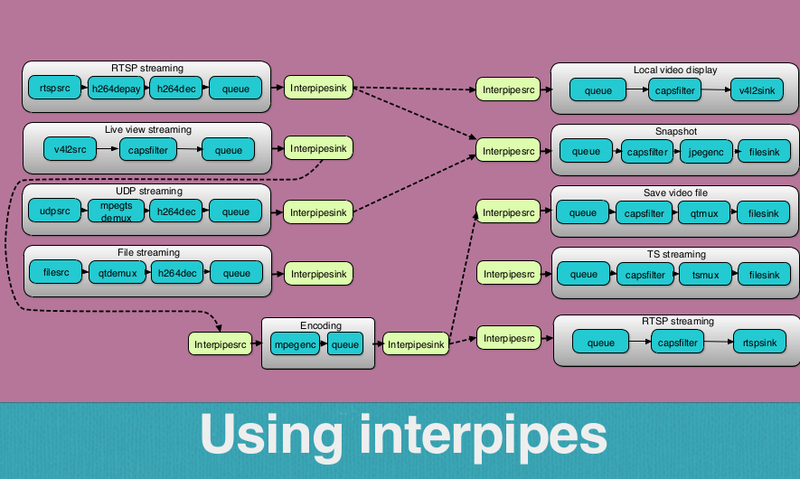GstInterpipe: Difference between revisions
m (→Overview) |
No edit summary |
||
| Line 1: | Line 1: | ||
= Introduction = | = Introduction = | ||
GstInterpipe is a Gstreamer plug-in that allows communication between two independent pipelines. The concept behind the Interpipes Project is to simplify the construction of GStreamer applications, which often has the complexity of requiring dynamic pipelines. It transforms the construction process from low level pad probe manipulation to the higher level setting an element's parameter value. Application developers don't get mired down in stalled pipelines because one branch of a complex pipeline changed state. | GstInterpipe is a Gstreamer plug-in that allows communication between two independent pipelines. The plug-in consists of two elements: | ||
* interpipesink | |||
* interpipesrc | |||
Generally speaking, the idea is that given a source pipeline: | |||
<pre style="background:#d6e4f1"> | |||
v4l2src ! interpipesink name=video_src | |||
</pre> | |||
Various sink pipelines may listen to it by: | |||
<pre style="background:#d6e4f1"> | |||
interpipesrc name=live_preview listen-to=video_src ! xvimagesink | |||
interpipesrc name=snapshot listen-to-video_src num-buffers=1 ! jpegenc ! filesink location=snapshot.jpeg | |||
</pre> | |||
The state of each pipeline is independent, each one can manage events by their own and | |||
The concept behind the Interpipes Project is to simplify the construction of GStreamer applications, which often has the complexity of requiring dynamic pipelines. It transforms the construction process from low level pad probe manipulation to the higher level setting an element's parameter value. Application developers don't get mired down in stalled pipelines because one branch of a complex pipeline changed state. | |||
For example, take a look in a complex pipeline like the one in the figure 1: | For example, take a look in a complex pipeline like the one in the figure 1: | ||
[[File:Complex_pipeline.png|thumb|center|800px|Figure 1: Complex Pipeline]] | [[File:Complex_pipeline.png|thumb|center|800px|Figure 1: Complex Pipeline]] | ||
The complex pipeline of figure 1 can be constructed into smaller, independent pipelines using interpipe elements as it is illustrated in the figure 2: | The complex pipeline of figure 1 can be constructed into smaller, independent pipelines using interpipe elements as it is illustrated in the figure 2: | ||
[[File:Interpipe_pipeline.png|thumb|center|800px|Figure 2: Pipeline using Interpipes]] | [[File:Interpipe_pipeline.png|thumb|center|800px|Figure 2: Pipeline using Interpipes]] | ||
This way the stream flow in a complex pipeline is reduced to simply set the correct listeners in the interpipe elements taking away the complexity of re-configuring pads or some other complex and error-prone logic. | |||
== GStreamer Plug-In == | == GStreamer Plug-In == | ||
The Interpipe plug-in | |||
= Getting the Software = | = Getting the Software = | ||
Revision as of 15:30, 27 April 2016
Introduction
GstInterpipe is a Gstreamer plug-in that allows communication between two independent pipelines. The plug-in consists of two elements:
- interpipesink
- interpipesrc
Generally speaking, the idea is that given a source pipeline:
v4l2src ! interpipesink name=video_src
Various sink pipelines may listen to it by:
interpipesrc name=live_preview listen-to=video_src ! xvimagesink interpipesrc name=snapshot listen-to-video_src num-buffers=1 ! jpegenc ! filesink location=snapshot.jpeg
The state of each pipeline is independent, each one can manage events by their own and
The concept behind the Interpipes Project is to simplify the construction of GStreamer applications, which often has the complexity of requiring dynamic pipelines. It transforms the construction process from low level pad probe manipulation to the higher level setting an element's parameter value. Application developers don't get mired down in stalled pipelines because one branch of a complex pipeline changed state.
For example, take a look in a complex pipeline like the one in the figure 1:

The complex pipeline of figure 1 can be constructed into smaller, independent pipelines using interpipe elements as it is illustrated in the figure 2:

This way the stream flow in a complex pipeline is reduced to simply set the correct listeners in the interpipe elements taking away the complexity of re-configuring pads or some other complex and error-prone logic.
GStreamer Plug-In
The Interpipe plug-in
Getting the Software
GstInterpipe is an open source project and can be downloaded from GitHub. The project is hosted at:
TODO
As with every open source project, there's an open invitation to provide feedback to the maintainers as bug reports, feature requests and even source code collaborations. The following table summarizes the recommended methods to collaborate with RidgeRun:
| Collaboration | Method |
|---|---|
| Bug report | GitHub's issue tracker |
| Feature request | GitHub's issue tracker |
| Patch Submission | Pull request |
Installation Guide
Dependencies
GStreamer 1.0.0
Building the project
Installing the plugin
User Guide
Features
Buffer Forwarding
Dynamic Switching
Caps Negotiation
Event Forwarding
Timestamp Synchronization
Properties
GstInterPipeSink
GstInterPipeSrc
==
